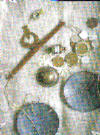Piña is a fiber made from the leaves of a pineapple and is commonly used in the Philippines. It is sometime combined with silk or polyester to create a fabric . The end fabric is lightweight, easy to care for and has an elegant appearance similar to linen.
Piña comes from the leaves of the pineapple plant. "Each strand of the hand scrapped Piña fiber is knotted one by one to form a continuous filament for hand weaving into the Piña cloth". The piña fiber is soft, has a high luster, and is usually white or ivory in color. Since piña is from a leaf, the leaf has to first be cut from the plant. Then the fiber is pulled or split away from the leaf. Most leaf fibers are long and somewhat stiff. Piña is often just referred to as pineapple fiber.
A major use for piña fabric is in the creation of the Barong Tagalog, Filipiniana dresses, and other formal wear that is common in the Philippines. It is also used for other table linens, bags, mats and other clothing items, or anytime that a lightweight, but stiff and sheer fabric is needed.
Pina, or pineapple fiber, is obtained from the large leaves of the pineapple plant naturally found in tropical countries like the Philippines. This natural fiber is soft and lustrous and woven into pina cloth. The fiber is soft, durable and resistant to moisture.
ABEL ILOCO CLOTH
The “industrial history” of Vigan is still evident in ancient crafts that were introduced by the Chinese merchants long before the arrival of the Spaniards.
Abel Iloco is known throughout the country and overseas for their durability. As a whole, products from Ilocos handlooms are utilitarian: for that matter, traditional crafts of the Ilocanos are meant for day-to-day rugged wear.
A Spanish chronicler, Dr. Antonio Morga wrote in 1610 in his Sucesos de las Islas Filipinas that the American Plain Indians heavily favored the thick and coarse type of cotton blankets coming from the Ilocos.
The abel loom weaving still thrives to this day in four barangays of Vigan, and in the neighboring towns of Caoayan, Bantay, Santa and Santiago.
MALONG CLOTH FROM MINDANAO
The malong is a woven Maranao multi-colored cloth bearing variety of okir designs. The well-organized shapes indicate the weaver's village of origin. The garment can function as blanket, bedsheet, dressing room, hammock, prayer mat and for cultural events of the Maranaos. A newborn is wrapped in a malong and as he grows this piece of cloth becomes a part of his daily life. When he dies, he is once again wrapped in a malong.
53 M. Paterno St., San Juan, Metro Manila, Philippines
mobile: (63)918-9275470 ; (63)918-9293144
landline: (632)726-9813 ; (632)997-8779
Copyright Ó Goldcraft & Fashion International, Inc. 2007






